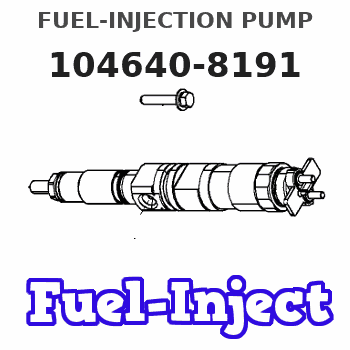Information fuel-injection pump
BOSCH
9 461 626 402
9461626402
ZEXEL
104640-8191
1046408191

Rating:
Include in #2:
104740-8191
as FUEL INJECTION PUMP
Cross reference number
Zexel num
Bosch num
Firm num
Name
Information:
Problem 36: Soot In The Inlet Manifold
Probable Cause:1. On 3116 Engines a small amount of soot is normal. This is due to the design characteristics of the engine. Valve overlap allows the intake to open slightly before the exhaust stroke has been completed, which will allow some soot to be pushed into the inlet manifold.Problem 37: Air In Fuel
Probable Cause:With air in the fuel system the engine will normally be difficult to start, run rough and release a large amount of white smoke. If air is in the system, it will generally get in on the suction side of the fuel transfer pump. Check for leakage at the connections between the fuel tank and the fuel transfer pump. If leaks are found, tighten the connections or replace the lines. The fuel priming pump (if equipped) may be used to remove the air from the fuel filter and fuel gallery (in the cylinder head), and fill the fuel system with fuel from the fuel tank before the engine is started.If there are no visual leaks, remove the fuel supply line from the tank and connect it to an outside fuel supply. If this corrects the problem, the suction line (standpipe) inside the fuel tank has a leak.If this does not correct the problem, install a sight tube in the fuel return line and check the injectors to verify that they are properly seated. This can be accomplished by moving each injector (one at a time) to the "FUEL ON" position momentarily and checking the sight tube for any increase in air bubbles. Push on the rack bar on the exhaust manifold side of the injector to move the injector to the "FUEL ON" position. If an increase in air is found, then remove that injector. Check the tip seal (O-ring) and replace it if it is found to be defective. Inspect the injector sleeve for a smooth sealing surface for the injector to seat on. If any defects are noted, the sleeve can be reamed or it can be replaced if necessary.The temperature of an exhaust manifold port can be an indication of a cylinder that has air being delivered to it. Check the exhaust manifold temperatures and compare the results. A lower than normal cylinder temperature indicates that the cylinder may be receiving air from the injector.The color of the exhaust smoke can also indicate which cylinder has a combustion leak. Move each injector (one at a time) to the "FUEL ON" position momentarily while checking the color of the exhaust smoke. The cylinder that has air will produce smoke that is gray or white in color.
Probable Cause:1. On 3116 Engines a small amount of soot is normal. This is due to the design characteristics of the engine. Valve overlap allows the intake to open slightly before the exhaust stroke has been completed, which will allow some soot to be pushed into the inlet manifold.Problem 37: Air In Fuel
Probable Cause:With air in the fuel system the engine will normally be difficult to start, run rough and release a large amount of white smoke. If air is in the system, it will generally get in on the suction side of the fuel transfer pump. Check for leakage at the connections between the fuel tank and the fuel transfer pump. If leaks are found, tighten the connections or replace the lines. The fuel priming pump (if equipped) may be used to remove the air from the fuel filter and fuel gallery (in the cylinder head), and fill the fuel system with fuel from the fuel tank before the engine is started.If there are no visual leaks, remove the fuel supply line from the tank and connect it to an outside fuel supply. If this corrects the problem, the suction line (standpipe) inside the fuel tank has a leak.If this does not correct the problem, install a sight tube in the fuel return line and check the injectors to verify that they are properly seated. This can be accomplished by moving each injector (one at a time) to the "FUEL ON" position momentarily and checking the sight tube for any increase in air bubbles. Push on the rack bar on the exhaust manifold side of the injector to move the injector to the "FUEL ON" position. If an increase in air is found, then remove that injector. Check the tip seal (O-ring) and replace it if it is found to be defective. Inspect the injector sleeve for a smooth sealing surface for the injector to seat on. If any defects are noted, the sleeve can be reamed or it can be replaced if necessary.The temperature of an exhaust manifold port can be an indication of a cylinder that has air being delivered to it. Check the exhaust manifold temperatures and compare the results. A lower than normal cylinder temperature indicates that the cylinder may be receiving air from the injector.The color of the exhaust smoke can also indicate which cylinder has a combustion leak. Move each injector (one at a time) to the "FUEL ON" position momentarily while checking the color of the exhaust smoke. The cylinder that has air will produce smoke that is gray or white in color.